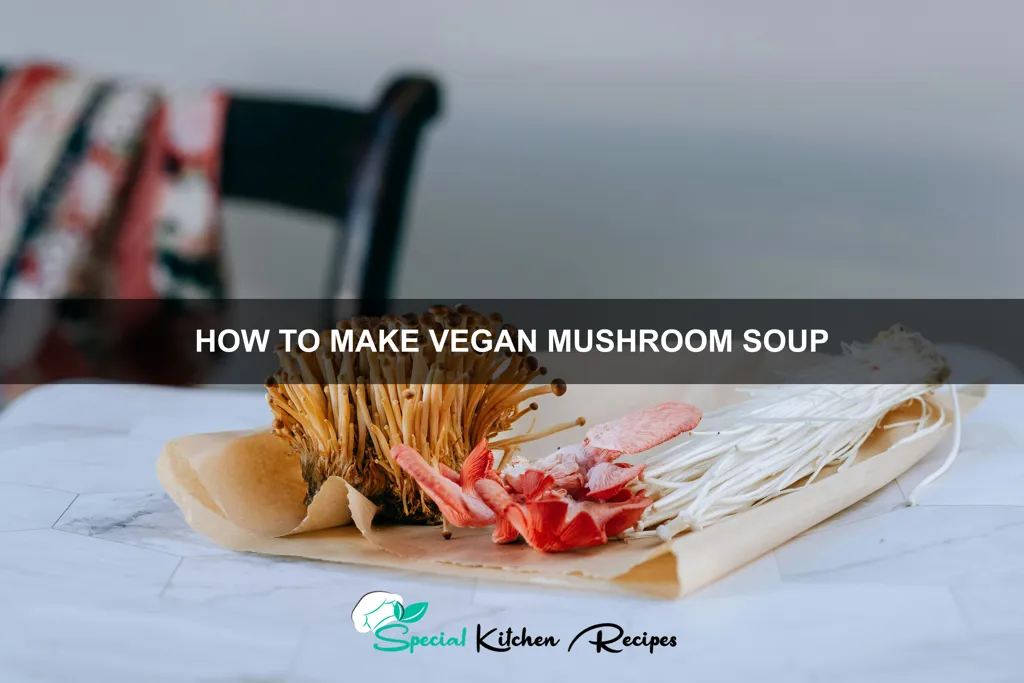Mushroom soup, a culinary comfort enjoyed across the globe, boasts a rich and varied history. While pinpointing its exact origins is difficult, evidence suggests variations existed in ancient civilizations, with recipes possibly dating back to Roman times. Early versions likely featured foraged mushrooms and simple broths, reflecting the readily available ingredients of the era. The development of cultivation techniques broadened the range of mushrooms used, leading to regional variations and the evolution of more complex recipes. For example, creamy mushroom soups, often featuring heavy cream and roux, became popular in European cuisine, particularly in France.
The rise of veganism in recent decades has led to a surge in popularity of plant-based interpretations of classic dishes, including mushroom soup. Globally, the vegan food market is experiencing exponential growth, with estimates projecting a value exceeding $74 billion by 2027. This increase is driven by factors like health concerns, environmental awareness, and ethical considerations surrounding animal welfare. This growing market has fueled innovation in vegan cooking, resulting in delicious and accessible alternatives to traditional recipes, like this vegan mushroom soup recipe.
Interestingly, mushrooms themselves hold cultural significance in various societies. In some cultures, certain mushrooms are considered delicacies, while others hold spiritual or medicinal importance. For example, certain types of mushrooms feature prominently in traditional Chinese medicine. The versatility of mushrooms, their earthy umami flavor, and their ability to absorb the flavors of other ingredients make them ideal for creating a hearty and satisfying vegan soup. This recipe demonstrates how easily mushrooms can be the star of a dish, creating a deeply flavorful and nutritious meal without relying on any animal products. The nutritional benefits of mushrooms, rich in vitamins and minerals, further enhance the appeal of this vegan option.
Ingredients and Measurements
This recipe yields approximately 6 servings of rich and flavorful vegan mushroom soup. Accurate measurements are crucial for achieving the desired consistency and taste. We recommend using a kitchen scale for the most precise results, especially for the mushrooms and vegetables.
Mushrooms: 1 pound (450g) mixed mushrooms are ideal. We suggest using a combination of cremini, shiitake, and oyster mushrooms for a complex umami flavor. Feel free to experiment with your favorite varieties! Avoid using too many button mushrooms as they can lack the depth of flavor other varieties offer. Clean the mushrooms thoroughly with a damp cloth or brush, avoiding washing them under running water, which can make them soggy.
Aromatics: 1 large yellow onion (approximately 1 cup chopped), 2 cloves garlic (minced), and 1 tablespoon of fresh thyme leaves are essential for building a fragrant base. Don’t skimp on the garlic! Its pungent aroma complements the earthy mushrooms beautifully. If fresh thyme isn’t available, 1 teaspoon of dried thyme can be substituted, but remember that dried herbs are more potent.
Liquid Base: 4 cups (950ml) of vegetable broth forms the foundation of the soup. Use a high-quality broth for the best flavor. Homemade broth is preferred, but store-bought low-sodium varieties work well too. You can also add 1 cup (240ml) of plant-based milk (like soy, oat, or almond milk) at the end for extra creaminess, but this is optional.
Other Ingredients: 2 tablespoons of olive oil will help sauté the aromatics and mushrooms properly. 1 tablespoon of all-purpose flour (or gluten-free alternative) will thicken the soup to a desirable consistency. Ensure the flour is cooked thoroughly to avoid a raw flour taste. Season generously with salt and freshly ground black pepper to taste. Consider adding a pinch of nutmeg for warmth – it complements mushrooms wonderfully. Finally, a tablespoon of nutritional yeast for a cheesy flavor is optional but highly recommended.
Optional Garnishes: Fresh parsley, chives, or a swirl of vegan cream can elevate the presentation and taste. Toasted croutons or a drizzle of truffle oil (for a luxurious touch) can also be added as garnishes.
Important Note: Adjust the amount of salt and pepper according to your preference. Taste the soup before serving and season accordingly. If the soup is too thick, add more broth; if too thin, simmer it uncovered for a longer time to reduce the liquid.
Mise en Place (Preparation of Ingredients)
Before you begin cooking your vegan mushroom soup, meticulously preparing your ingredients – mise en place – is crucial for a smooth and efficient cooking process. This ensures consistent cooking and prevents last-minute scrambling. We’ll be making a rich and flavorful soup using 1 pound of cremini mushrooms, ½ pound of shiitake mushrooms, and 1 medium yellow onion.
Begin by cleaning the mushrooms. Avoid washing mushrooms under running water, as they will absorb too much moisture, resulting in a watery soup. Instead, use a damp cloth or mushroom brush to gently wipe away any dirt or debris from their surfaces. For particularly stubborn dirt, you can carefully trim the ends of the stems.
Once cleaned, slice the cremini mushrooms into roughly ¼-inch thick slices. The shiitake mushrooms, with their firmer texture, can be sliced slightly thicker, about ⅓-inch thick. Different mushroom varieties cook at different rates, but similar sizing ensures even cooking.
Peel and finely chop the yellow onion. Aim for a consistent dice of about ½-inch. This ensures even caramelization and prevents some pieces from burning before others are cooked through. For a smoother soup, you may consider briefly sautéing the onions before adding the mushrooms, but this is optional.
Next, prepare your aromatics. We’ll be using 2 cloves of garlic, 2 sprigs of fresh thyme, and 1 bay leaf. Mince the garlic finely. Finely minced garlic allows for even distribution of flavour throughout the soup, preventing strong, concentrated pockets of garlic taste. Remove the leaves from the thyme sprigs. You can roughly chop them or leave them whole, depending on your preference for the final texture of the soup.
Finally, measure out your liquids. We’ll need 4 cups of vegetable broth (low sodium preferred) and ½ cup of dry white wine (optional, but adds depth of flavor). Have these ready to pour directly into the pot. If using dry white wine, ensure it’s a good quality, as its flavor will be noticeable in the final product. For a creamier texture, you might also prepare 1/4 cup of vegan cream or cashew cream.
With all your ingredients prepped and measured, you’re ready to start cooking! This careful preparation will elevate your vegan mushroom soup from good to exceptional.
Sautéing the Vegetables
This step is crucial for developing deep, rich flavors in your vegan mushroom soup. We’ll be sautéing a medley of vegetables to build a complex foundation for the soup’s taste. Begin by gathering your ingredients: 1 large onion (about 1 cup chopped), 2 carrots (about 1 cup chopped), 2 celery stalks (about 1 cup chopped), and 2 cloves of garlic (minced). You’ll also need 2 tablespoons of olive oil.
Heat the olive oil: In a large, heavy-bottomed pot or Dutch oven (at least 6 quarts), heat the olive oil over medium heat. A heavy pot helps to ensure even cooking and prevents burning. Avoid using high heat, as this can scorch the vegetables before they soften properly.
Add the onion, carrots, and celery: Add the chopped onion, carrots, and celery to the pot. Stir to coat them evenly with the olive oil. Sauté for about 8-10 minutes, stirring occasionally, until the onions are translucent and the carrots and celery begin to soften. Don’t rush this process; allowing the vegetables to cook slowly will enhance their sweetness and flavor.
Add the garlic: Add the minced garlic to the pot and sauté for another minute, or until fragrant. Be careful not to burn the garlic, as this will impart a bitter taste. The garlic should be cooked through but not browned. At this stage, you’ll notice the vegetables releasing their natural moisture, creating a slightly softened base.
Professional Tip: For an even deeper flavor, consider adding a tablespoon of tomato paste along with the garlic. Sauté for another minute to cook out the raw tomato taste. This adds umami and richness to the soup.
Seasoning: Once the vegetables are softened, season them with salt and freshly ground black pepper to taste. About ½ teaspoon of salt and ¼ teaspoon of black pepper is a good starting point, but adjust to your preference. Taste and adjust seasoning at each stage for optimal flavor balance.
Next Steps: Once the vegetables are perfectly sautéed, you’re ready to add the mushrooms and continue with the recipe. The well-sautéed vegetables will provide a delicious base for your creamy and flavorful vegan mushroom soup.
Simmering the Soup
Once you’ve sautéed your mushrooms and aromatics, it’s time to build the flavor foundation of your vegan mushroom soup. This simmering stage is crucial for developing a rich and deep taste. We’ll be using approximately 6 cups of vegetable broth, but feel free to adjust based on your desired consistency.
Begin by adding 6 cups of your favorite vegetable broth to the pot containing the sautéed mushrooms and onions. Ensure the broth completely covers the mushrooms. If needed, add a little more broth or water to achieve this. Scrape the bottom of the pot well to loosen any browned bits from the sautéing process – these little nuggets of flavor are pure gold!
Next, add 1 teaspoon of dried thyme, ½ teaspoon of dried rosemary, and a generous pinch of salt and black pepper. Adjust seasoning to your preference; taste and adjust accordingly. Remember that flavors will intensify as the soup simmers. For a richer, more umami-forward soup, consider adding 1 tablespoon of soy sauce or tamari at this stage. This will also enhance the overall savory notes.
Bring the mixture to a gentle simmer over medium-low heat. Avoid a vigorous boil, as this can make the soup cloudy and potentially break down the mushrooms prematurely. A low simmer allows the flavors to meld beautifully and the mushrooms to soften perfectly. Reduce the heat to the lowest setting that maintains a gentle simmer.
Now, let the soup simmer uncovered for at least 20 minutes, or even up to 30 minutes for a deeper, more intense flavor. The longer it simmers, the more the flavors will develop. During this time, you can occasionally check the liquid level and add a little more broth if necessary, particularly if you prefer a thinner soup. Stir gently every 5-10 minutes to ensure even cooking and prevent sticking.
Once the soup has simmered to your liking and the mushrooms are tender, you’re ready to move on to the blending and finishing stages. Taste the soup one last time and adjust the seasoning as needed. You may want to add more salt, pepper, or herbs to achieve your ideal flavor profile.
Remember, patience is key during the simmering process. Allowing the soup to simmer gently for an extended period will reward you with a deeply flavorful and satisfying vegan mushroom soup.
Blending (Optional)
While not strictly necessary, blending your vegan mushroom soup can significantly enhance its texture and create a creamier, smoother consistency. This step is particularly beneficial if you prefer a velvety soup or if you’ve used mushrooms with a more fibrous texture, like portobellos. Whether you choose to blend all or part of the soup is entirely up to you, allowing for customization to your preference.
For a completely smooth soup: Once your soup has simmered and all the flavors have melded, allow it to cool slightly before blending. This is crucial for safety, as hot liquids can cause dangerous pressure build-up inside a blender. Never fill a blender more than halfway to allow for proper ventilation and prevent spills. Working in batches, carefully transfer the soup into your blender. Use a high-speed blender for the best results. Blend until completely smooth and creamy, scraping down the sides as needed. This will take approximately 1-2 minutes depending on the power of your blender and the quantity of soup.
For a partially blended soup: If you prefer a slightly chunkier texture, you can opt for a partial blend. Reserve about 1/3 to 1/2 of the soup before blending the remaining portion. Blend the reserved portion until smooth, then gently stir it back into the unblended portion. This technique creates a delightful contrast in textures, offering both creamy smoothness and the satisfying bite of whole mushrooms. Adjust the ratio of blended to unblended soup to achieve your desired texture.
Equipment Recommendations: A high-powered blender like a Vitamix or Blendtec is ideal for achieving a perfectly smooth soup, especially if you’re working with tougher mushrooms. However, a standard blender will work perfectly fine, just be prepared to blend in smaller batches and possibly for a longer duration. Consider using an immersion blender directly in the pot for a convenient and less messy alternative, particularly if you’re making a smaller batch or prefer a slightly less smooth texture.
Troubleshooting: If your soup is too thick after blending, you can thin it out by adding a little more vegetable broth or water, a tablespoon at a time, until you reach your desired consistency. Conversely, if it’s too thin, you can simmer it uncovered for a few minutes to reduce the liquid and thicken the soup naturally. Always taste and adjust seasoning after blending, as the flavors might have slightly changed during the process.
Ultimately, the decision to blend your vegan mushroom soup is a matter of personal preference. Experiment with different blending techniques to find the texture that best suits your palate and enjoy the delicious results!
Seasoning and Flavor Adjustments
Seasoning is crucial for a delicious vegan mushroom soup. Don’t be shy with your spices! Start by tasting your soup after the mushrooms have cooked down and before adding the cream. This allows you to adjust the base flavor profile before incorporating the richness of the coconut milk or other creamy element.
Salt and Pepper: Begin with 1 teaspoon of salt and ½ teaspoon of freshly ground black pepper. These are your foundational seasonings. Taste and adjust accordingly. Salt enhances the other flavors, so don’t be afraid to add more gradually until you achieve the desired level of saltiness. Freshly ground pepper adds a subtle warmth and complexity.
Umami Boosters: Mushrooms themselves possess a degree of umami, but you can amplify this savory depth. Consider adding 1 teaspoon of soy sauce or tamari (for gluten-free options), or ½ teaspoon of nutritional yeast for a cheesy, nutty flavor. A pinch of dried porcini mushroom powder (about ¼ teaspoon) can also significantly enhance the mushroomy character of your soup.
Herbs and Spices: Experiment with herbs and spices to complement the earthy notes of the mushrooms. A classic combination is thyme and rosemary. Add 1 teaspoon of dried thyme or 2 teaspoons of fresh thyme leaves, and ½ teaspoon of dried rosemary or 1 teaspoon of fresh rosemary. Other options include sage, marjoram, or even a pinch of smoked paprika for a smoky undertone. Remember to add herbs towards the end of cooking to preserve their delicate flavors.
Acidic Balance: A touch of acidity can brighten the overall flavor profile and balance the richness of the soup. A squeeze of lemon juice (about ½ to 1 tablespoon) or a splash of white wine vinegar (about 1 teaspoon) can work wonders. Add this at the very end and taste carefully, as too much acidity can overpower the other flavors.
Adjusting Thickness: If your soup is too thin, you can thicken it by simmering it uncovered for a longer period to reduce the liquid. Alternatively, you can blend a portion of the soup until smooth and then stir it back into the pot for a creamier texture. Avoid adding flour or cornstarch as thickeners, as they can negatively impact the soup’s texture and flavor.
Taste and Adjust Repeatedly: The most important piece of advice is to taste your soup at various stages of the cooking process. Seasoning is a journey, not a destination. Make small adjustments, taste frequently, and trust your palate to guide you to the perfect flavor balance.
Recommendations
For the richest flavor, allow your vegan mushroom soup to simmer gently for at least 30 minutes, allowing the mushrooms to release their umami. This slow cooking process will deepen the overall taste and create a more satisfying texture.
Serving Suggestions: This hearty soup is delicious served with crusty bread for dipping, especially a sourdough or a rustic loaf. A dollop of vegan sour cream or cashew cream adds a delightful tangy richness. Garnish with fresh herbs like parsley or chives for a pop of color and freshness. Consider adding a sprinkle of toasted nuts, such as walnuts or pecans, for added crunch and flavor.
Storage: Store leftover soup in an airtight container in the refrigerator for up to 4 days. Allow the soup to cool completely before refrigerating to prevent bacterial growth. You can also freeze the soup for longer storage; it will keep for up to 3 months in the freezer. Thaw overnight in the refrigerator before reheating.
Complementary Dishes: This vegan mushroom soup pairs beautifully with a variety of dishes. It’s a wonderful starter before a main course of grilled tofu steaks or a hearty vegan lentil loaf. A simple side salad with a light vinaigrette would also complement the richness of the soup. For a complete meal, consider serving it with a side of crusty bread and a fresh green salad.
Nutritional Information (per serving, approximate): The nutritional content will vary depending on the specific ingredients and quantities used. However, a typical serving of vegan mushroom soup contains approximately 250-300 calories, 10-15g of protein, 20-30g of carbohydrates, and 10-15g of fat. It’s a good source of fiber, vitamins, and minerals, particularly potassium and vitamin B. Note: This is an estimate and should not be considered a substitute for professional nutritional advice. For precise nutritional information, use a nutrition calculator with your specific recipe ingredients and quantities.





